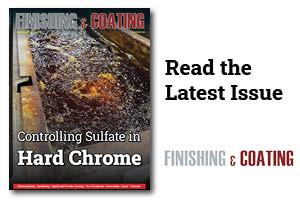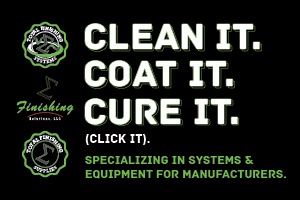Safety is prevalent in the metal finishing industry. It takes no back seat or second place.
 Stephen Rudy CEFNo matter how big or small. No matter if it is a manual or automated process line or system. An example of importance is selecting the types of chemical process baths and available treatments. The user may acknowledge benefits from either or both. In any case, the available selections are tried and true in their respective applications.
Stephen Rudy CEFNo matter how big or small. No matter if it is a manual or automated process line or system. An example of importance is selecting the types of chemical process baths and available treatments. The user may acknowledge benefits from either or both. In any case, the available selections are tried and true in their respective applications.
Adherence to vendor recommendations in their technical literature, drum labels, and SDS is a big step in safety when using all the materials discussed. Protective clothing, proper eyewear, and face shields are typically specified.
Surface Preparation
Alkaline Cleaning
Two types of product concentrates are widely used for soak and electrocleaning. These are powdered and liquid-based cleaners. Both systems contain similar additives such as alkalinity builders, buffers, surfactants, wetting agents, descalers, water conditioners, and inhibitors. The cleaning dynamics and bath service lives are comparable. Operating costs up front are similar. Although looking at the total picture, liquid cleaners are more economical (much less sludging, easier to make up, easier to add, less downtime, sometimes easier to waste treat). These benefits, as will be noted, also include enhanced safety.
By comparing actual safety issues, the following practical facts can be readily confirmed for powdered cleaners:
- It is usually supplied in fiber drums. However, the drums can crack open due to mishandling or storage problems, spilling corrosive contents, resulting in major personal safety issues.
- Aging drums of opened or unopened cleaner tend to harden (moisture absorption). The clumping of product concentrate makes it very difficult to remove the contents when making additions. I have seen shovels and pick axes at work, causing broken-off clumps to fly in varying directions. Some innovators have even suspended drums above a tank. Cutting away the drum resulted in “boulders” of the cleaner tumbling into the process tank.
- Empty drums must be properly disposed of continually to avoid tying up plant floor space.
- Manual additions may cause dustiness, with fine powders settling on unprotected skin, causing burns and rashes.
- Additions must be made in gradual steps to avoid possible splashback due to the localized boiling of the added cleaner. Larger additions should be made to the cleaner significantly below its operating temperature.
- Good mixing is essential to prevent undissolved clumps from settling into the tank's bottom. Care must also be taken to avoid backsplash and spray.
- Cleaner spilled on the catwalk absorbs moisture, quickly forming a slippery condition.
- Portions of undissolved cleaner, along with sludging, increase tank clean-out time, worker safety issues, and production downtime prior to new cleaner makeup.
These safety issues are not meant to indict powdered cleaners. For decades past, present, and future, powdered cleaners comprise the first critical step in many process cycles. Finishers have successfully used powdered cleaners and will continue to do so, acknowledging these safety issues associated with their usage. OSHA and related government agencies, along with insurance carriers, focus more on safety. This is good for staff.
Liquid Cleaners
Liquid cleaners were not only developed to meet the rigorous cleaning applications that powdered blends excel at. Concentrated liquid blends have focused on significant advantages offered to the finisher, which encompass improved safety. These include the following points:
- Supplied in rigorous polyethylene drums and bulk sizes of totes, these drums better withstand handling than fiber drums. Totes are placed inside a protective mesh metal cage.
- The concentrated liquid blend cannot harden with time. However, protection from freezing temperatures is required.
- Liquids eliminate the problem of dustiness. However, spillage is a problem, and burns, rashes, and slippery floors are concerns.
- Additions can be made directly from a drum pump to the process tank, minimizing exposure and handling of the product. The drum or tote can be stored safely away from the cleaner tank, and contents are automatically added by a pump activated by a conductivity meter.
- Liquid blends are 100% mixed and will not agglomerate or clump in addition to the process tank. Moderate, thorough mixing of additions in the tank is quite simple, minimizing splashing.
- Cleaning out the tank after dumping the liquid cleaner bath is simpler and safer because there is much less sludge to be removed.
- Empty drums may be recycled. Totes are generally returnable, thus making them truly recyclable.
Liquid cleaners have found a niche, operating in many cleaning lines. They also provide an important first step in the surface preparation of parts. Although total safety is never 100% guaranteed, using liquid cleaners does provide the finisher with overall significant safety advantages compared to powders.
Acid Treatment
In somewhat of a twist, let us consider using liquid acids versus powdered acids. Both are essential to cleaning, descaling, derusting and overall surface activation before plating or other process steps. One system employs generic acids, while the other provides salts of acids that ionize when dissolved in water. Both processes adequately condition the surface. Each incorporates a degree of safety issues related to their chemical use. Acids must be handled with the appropriate caution and safety procedures, which include safety clothing, eye protection, and face shields.
Liquid Acids
These usually refer to hydrochloric or sulfuric, to a lesser degree, phosphoric and acetic. Since hydrochloric and sulfuric are typically used, both acids will be referenced. Safety-related issues include:
- They are highly corrosive. Upon contact, severe burning of exposed skin occurs. Hydrochloric acid concentrate fumes.
- Additions to tanks must be made gradually to cold water, with good mixing. Always add Acid to water! Sulfuric acid is especially exothermic, rapidly giving off lots of heat, resulting in localized boiling with the potential for splashback.
- Pickling and activating the metal surface produces corrosive fumes that must be properly vented.
- Sometimes mixed acids are required, such as for properly desmutting aluminum. Handling nitric, sulfuric, and hydrofluoric acids in specific combinations or together becomes a serious safety issue.
- Extreme care is necessary to prevent potentially catastrophic accidents.
- Empty carboys, drums, and acid totes should be returned promptly for refill. Reducing hazard clutter is important to handling safety.
Liquid acids are used in many finishing and waste treatment applications on a daily basis. The inherent safety issues are well known. Trained personnel, using proper procedures and precautions, handle and use these acids generally without harmful effects. Generic acids will always have a place in metal finishing because of their importance to specific surface treatments. Safety in understanding the materials and how to handle them will always be very important.
Powdered Acids
Powdered acids have been available to finishers for many years. This line of products was specifically developed to increase the effect of acid treatments while improving the safer handling and exposure situation. Powdered acids offer several advantages concerning improved safety. These include:
- Acid salts ionize upon dissolution to provide active acid in the bath. Common among these is Sodium Bisulfate, the acid salt of sulfuric acid. The safety benefit is eliminating the handling of sulfuric acid and the accompanying exothermic heating when added to water.
- Acid salts are blends offering additional acid accelerators, such as chlorides and fluorides. These agents also ionize in solution, providing hydrochloric and hydrofluoric acids upon dissolution of the powdered concentrate. A single product can eliminate the handling of two or three separate generic acids and their respective containers.
- Unlike liquid acids, powdered acids may contain surfactants and wetting agents. These additives promote improved penetration for surface action, which may result in using less product compared to higher concentrations of liquid for the same application.
- Surfactants and wetters in the powdered acids form a stable, light foam blanket. This may eliminate up to 99% of potentially corrosive fumes and mists.
- The powdered acids are supplied in sealed plastic liners inside the fiber drums. Caking and hardening on aging and storage in humid conditions may occur. Proper protective clothing and apparel minimize irritation to exposed skin and the potential for localized burns due to some dusty conditions when handling and making additions. Appropriate handling and storage precautions should be followed. The storage, handling, and shipping of empty liquid acid drums can be eliminated if the powdered acid meets the surface treatment requirement.
- Powdered acids may contain special inhibitors to prevent immersion deposits, such as copper on steel, thereby extending the bath’s service life.
- Powdered acids may also provide solution buffering action, improving the functioning of acid action over time. A benefit is less frequent solution dumps.
Blended Liquid-Acid Concentrate
An alternative to the powder acid concentrates is their blended liquid acid concentrate. This line of products consists of premix concentrated acids, which also contain accelerators, surfactants, and inhibitors, as described for the powder acids. Where applicable, they are dust-free, easier, and safer to dispense products.
Powdered acids and their liquid blended equivalents offer several safety advantages with respect to handling and use. These benefits along with improved performance have kept these products very popular among finishers. Activation is the next important step after cleaning in the surface preparation sequence. Generic acids and powdered acids can get the job done. Where safety and handling are concerned, powders offer an advantage.
Powder or liquid concentrate products decide which best fits and conforms to specific processing and conditioning requirements.
Stephen F. Rudy, CEF, is president of Chem Analytic and has written extensively about the finishing industry. Visit www.chemanalytic.com or call him at 917-604-5001.



































